Do you know how to save your losing stock trades using options?
Today SlashTraders will show you how to sell Covered Calls to hedge against your stocks. So you can earn a premium from selling options to reduce the cost basis of your stocks.
Even though Covered Call is the first strategy to learn about options trading, we share a few disadvantages of Covered Calls. So you know when not to trade Covered Calls.
Contents
What Is a Covered Call?
A Covered Call is an options trading strategy that hedges against a long stock position by selling OTM Call to collect a premium if the stock price doesn't rise.
Let's review the profit analysis of buying stocks. A long stock position has a 50% chance of profit. We profit when the price rises and lose when the price falls.
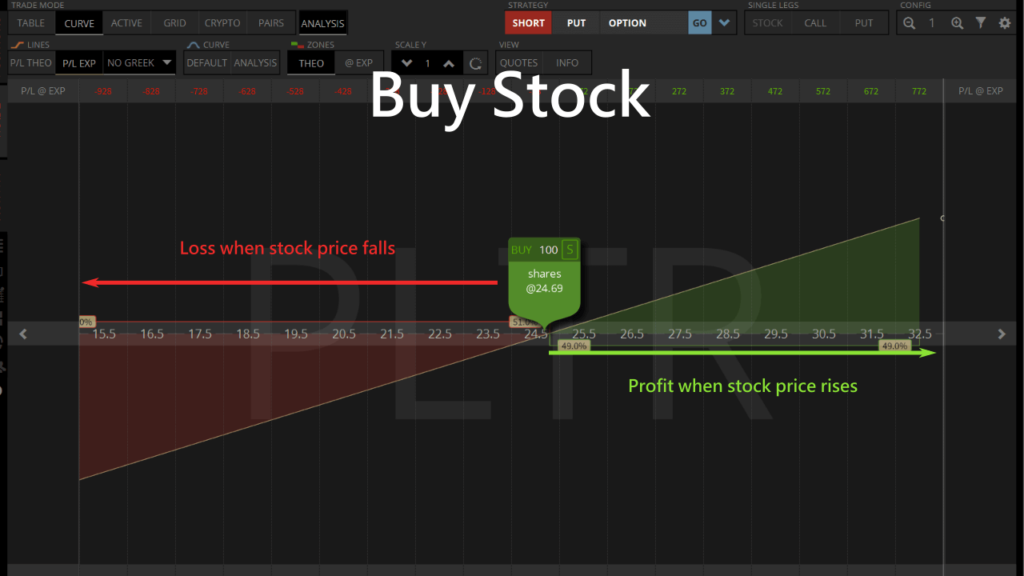
Selling an OTM Call option collects a premium. If the stock price does not increase past the strike price before expiration, the option contract expires worthless and we keep all the premium.
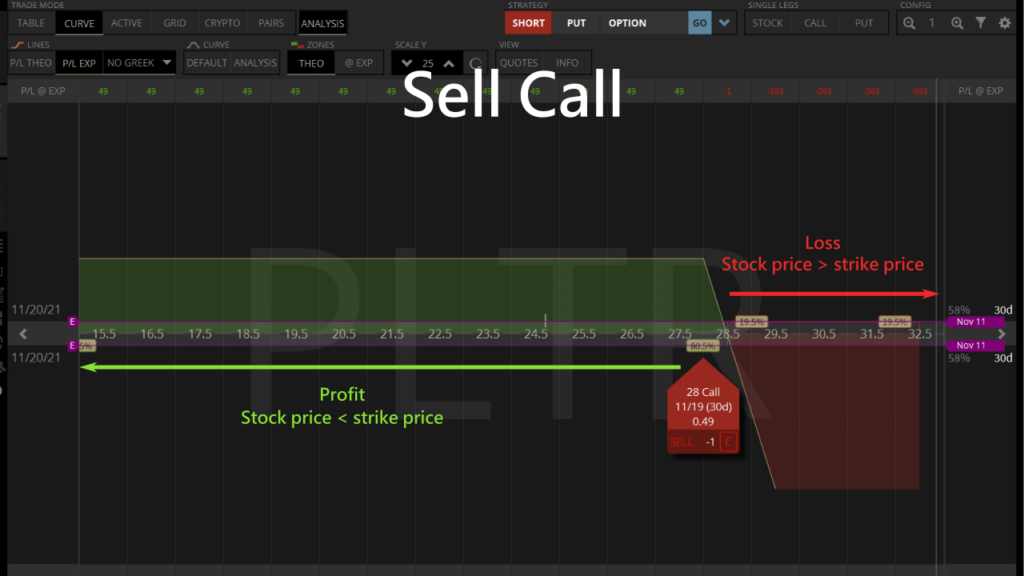
But if the stock price increases past the strike price, the maximum loss can be unlimited.
When we combine buying 100 shares with selling a Call option, we get a Covered Call strategy. The premium received from the short Call can reduce the cost of the stocks, and increase your chance of profit.
If the stock price increases past the Call strike before expiration, the 100 stocks will be sold at the strike price for a profit to compensate for the loss of the Call trade.
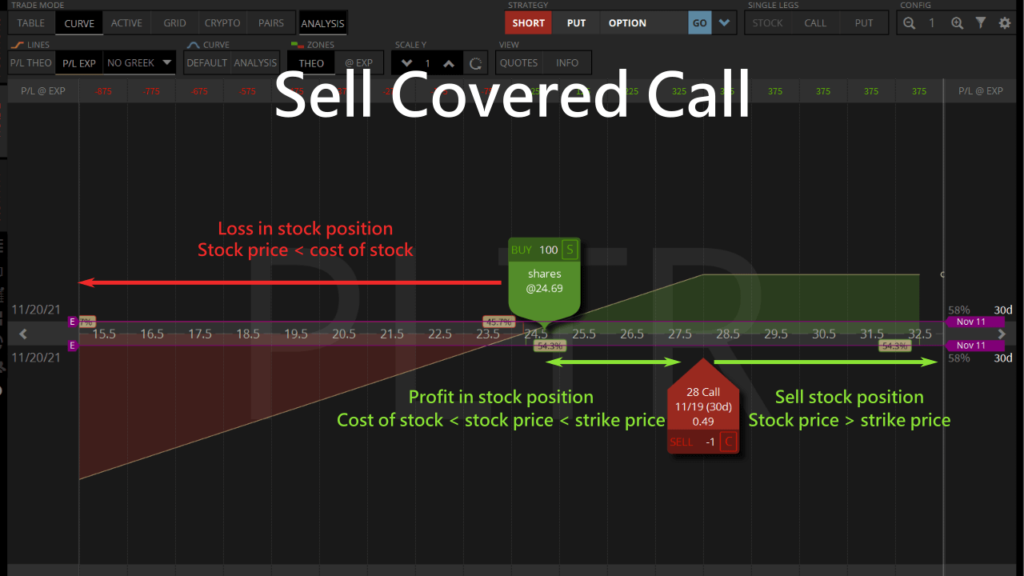
So a Covered Call caps the future upside of the stocks in exchange for the income from selling options.
Why Sell Covered Calls?
If we want to hold onto a stock for the long-term, but are afraid of a bearish trend, we can trade the Covered Call to hedge our position.
PLTR is one of the most popular stocks on the market. Since its $9 at IPO, it quickly rose to $45, before falling back to the current $24.
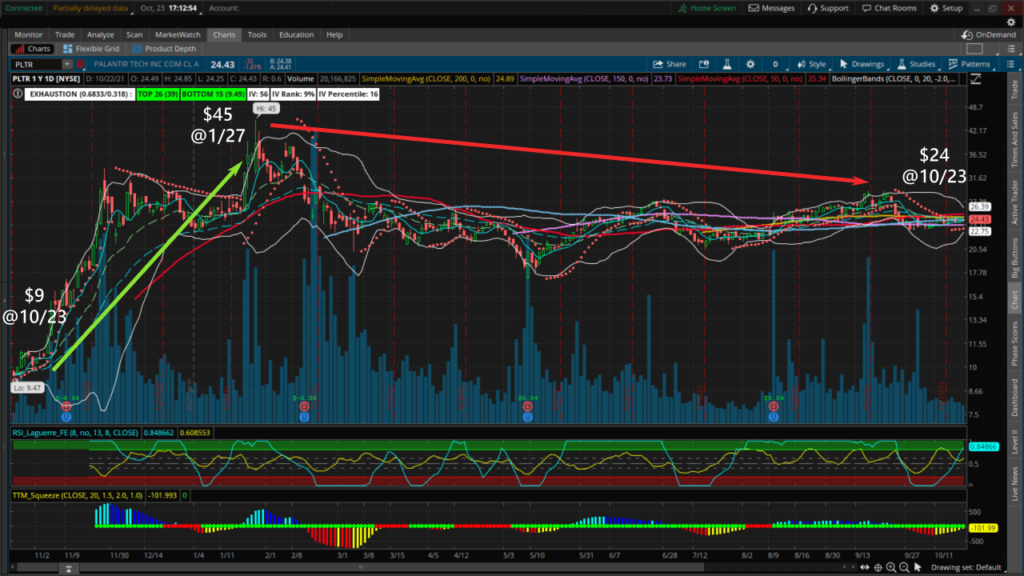
If we purchased 100 PLTR stocks at $45, we would have a losing position now. So we can trade the Covered Call to hedge and collect income while waiting for the stock to rise.
A 0.20 delta short Call at $28 that expires next month can receive $49.
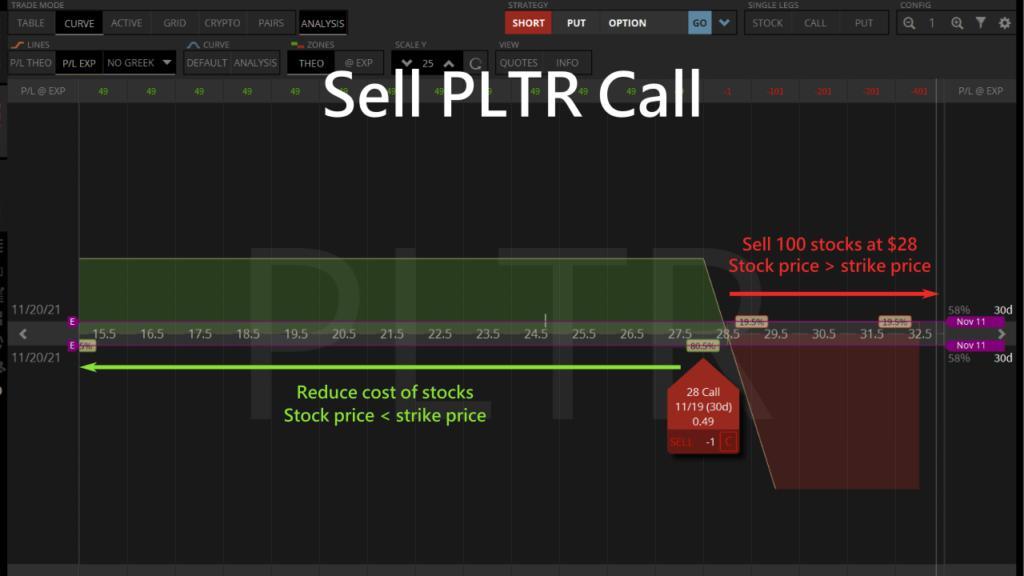
But if the stock price rises past $28 before expiration, our 100 stocks will be Called away at $28 for a loss.
If the stock price doesn't rise beyond $28, the Call option would expire worthless. Then the cost of our 100 PLTR stocks would be offset by $49 to become $4,451. Reducing the cost of each stock to $44.51.
The cost per share will continue to drop as you sell Covered Calls.
| Time | Cost of trade | Cost per share |
|---|---|---|
| 30 days | $4,451 | $44.51 |
| 60 days | $4,402 | $44.02 |
| 90 days | $4,353 | $43.53 |
| 120 days | $4,304 | $43.04 |
You may notice that if we want to make sure we profit from the trade, we need to sell a Covered Call at $45 or higher. This way if the stock price rises past the Call strike, we break even from selling the stocks.
But we find a $45 short Call has only 0.01 delta, so the premium received is extremely low at $3.
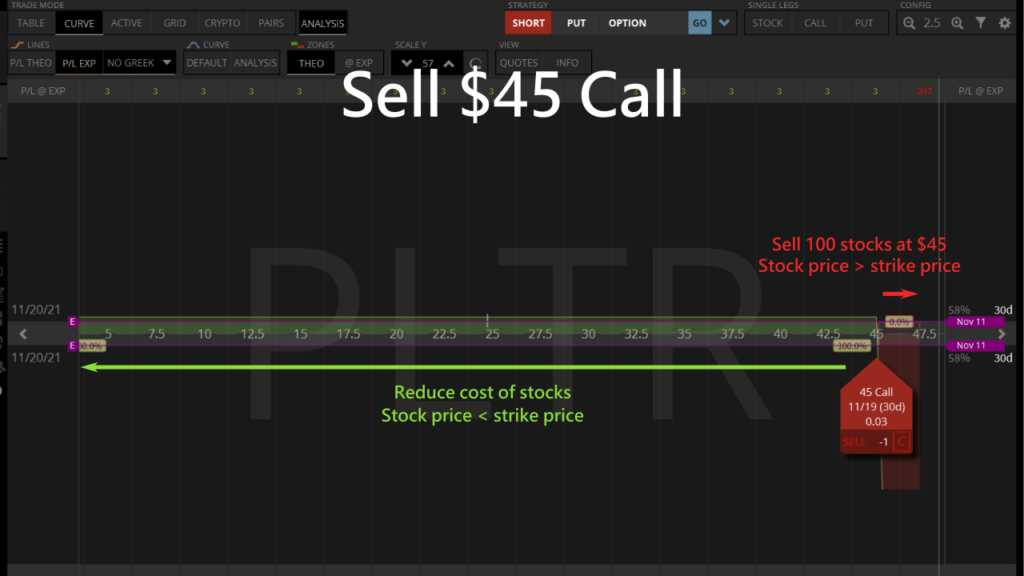
Therefore the trick to trading Covered Call on stocks is to find a high delta strike price that gives us a good premium without being breached before expiration.

3 Reasons Why We Don’t Sell Covered Calls
Even though the Covered Call is a key part of the Wheel Strategy, but there are 3 key reasons that we don't like to trade Covered Calls:
- A Covered Call requires too much capital and has very low returns.
- Good dividend stocks usually have poor option premiums.
- Covered Calls can miss out on sudden bullish trends of growth stocks.
1. A Covered Call Requires Too Much Capital and Has Very Low Returns
We can see the Covered Call requires the purchase of 100 stocks, which requires around $2,400 of capital investment.
While an ATM Bull Put Spread only requires $51 of Buying Power.
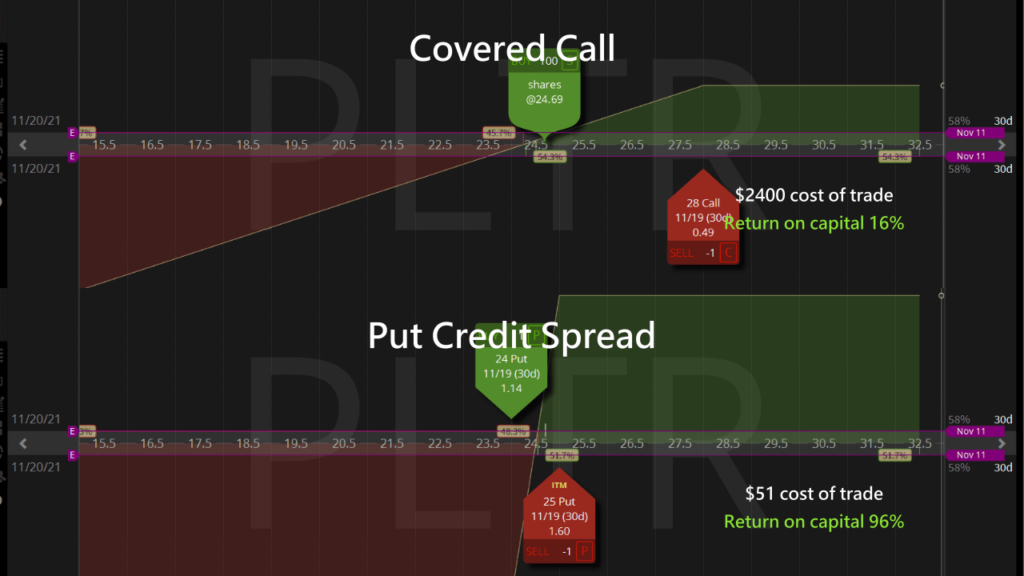
Despite both expiring in 30 days, the maximum return of a Covered Call strategy is 16% while the ATM Bull Put Spread has 96% return.
Then the annualised return of Covered Calls is 192%, while the ATM Put Spread's annual return is 1,152%.
| Strategies | Maximum monthly return | Maximum annual return |
|---|---|---|
| Covered Call | 16% | 192% |
| ATM Put Vertical Spread | 96% | 1,152% |
So there is an opportunity cost of using so much capital to trade Covered Calls for a low return. We recommend trading Poor Man's Covered Calls instead.
2. Good Dividend Stocks Usually Have Poor Option Premiums
Dividend stocks are poor candidates for trading Covered Calls, since dividend stocks or ETFs have lower IV, and therefore receive a lower premium from the Call options.
For example, trading a Covered Call for SPY at 0.20 delta would have a very low strike price, leading to a maximum return of 2.9%.
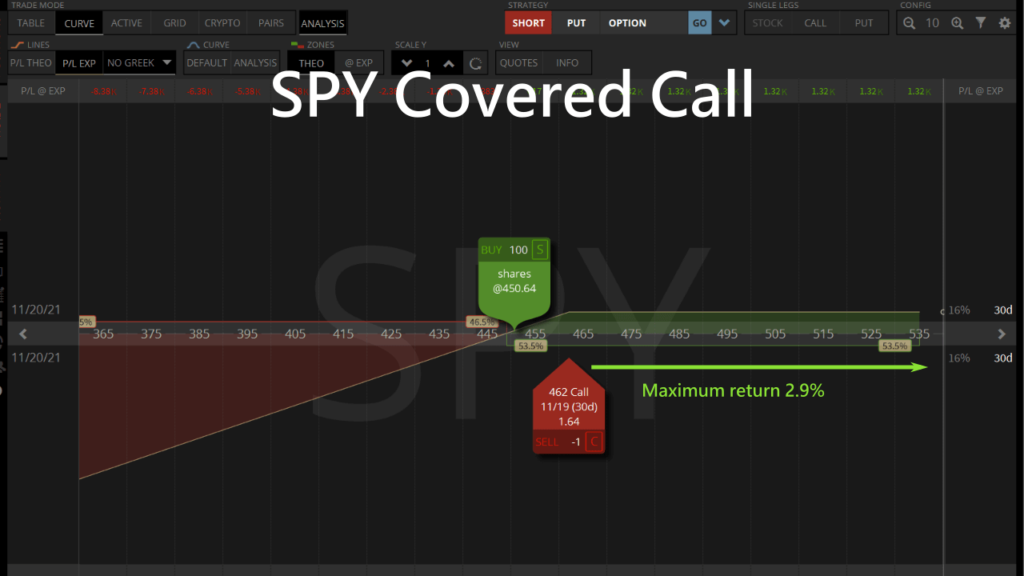
A better strategy is to buy and hold high dividend yield stocks to generate consistent dividend income for early retirement.
3. Covered Calls Can Miss Out on Sudden Bullish Trends of Growth Stocks
If we try selling Covered Calls on a high IV growth stock like TSLA, a 0.20 delta Covered Call has a maximum return of 11%.
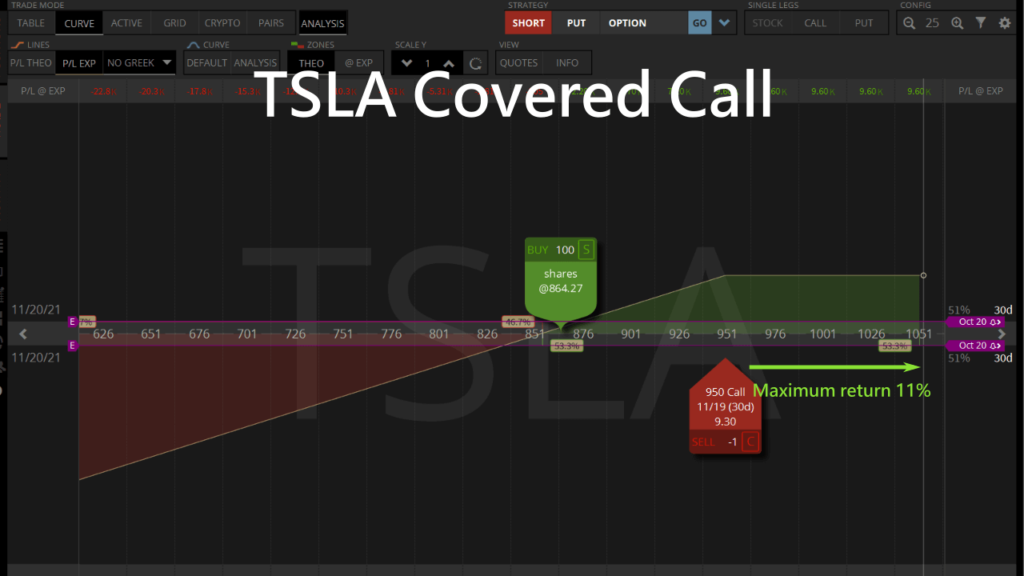
The strike price also gives us around $86 of upside potential.
Which looks good at first, until we realise that TSLA would experience bullish trends that gained $100 in 30 days. Such price bursts actually happened three times in the last year. If we traded Covered Calls for TSLA in the past year, we would have missed the big gains.

A better way to trade growth stocks is to anticipate bottom out signals and trade Bull Put Spreads.
When to Avoid Covered Calls?
Considering the drawbacks mentioned above, we can conclude that the following situations are not suitable for trading Covered Calls:
When the Cost of Owning 100 Shares Is Too High
SPY is one of the most popular long-term investment options. However, over the past few years, its stock price has fluctuated between USD 200 and USD 600. An investor needs to invest around USD 20,000 to USD 60,000 to hold 100 shares as part of a Covered Call.
For smaller investors, this makes it challenging to use Covered Calls to diversify their investments, which in turn limits their ability to spread out risk.
High-Volatility Stocks
Most tech stocks tend to either surge dramatically, as a market leader, or plummet due to obsolescence, which is why they often exhibit high implied volatility.
While high IV can provide opportunities to earn income from selling Calls through Vega, a significant rise in stock prices can cap the maximum profit from those Call contracts.
Extremely Bullish Stocks
Whenever popular investment topics arise, such as AR/VR or the metaverse a few years ago, and more recently AI, there tends to be a surge of excitement in stock purchases.
NVDA experienced nearly a tenfold increase from 2023 to 2024, and investors holding Covered Calls likely regretted the profit limitations imposed by the short Call contracts, as they could have seen a tenfold gain without them.
Therefore, when anticipating a significant short-term rise in a stock, using Covered Calls may not be the best strategy for securing profits. Simply holding the stock and waiting for substantial gains is often a wiser choice.
When to Use Covered Calls?
Covered Call is suitable for those looking to hold value stocks for the long term, particularly high-quality stocks with lower prices that offer stable dividends over time.
We utilise a Dividend Scanner to filter stocks that have consistently increased their dividends for at least 25 years. This helps us identify dividend aristocrats that are currently suitable for long-term investment, and we then sort by yield to uncover the best income opportunities.

When evaluating the listed dividend aristocrats, there are several key metrics to consider:
- Fair Value indicates a stock's true worth, so we should focus on those with a Fair Value higher than the current stock price. This presents a positive Upside opportunity that allows us to hold shares long-term for growth.
- Dividend Yield represents the expected annual return from dividends for holding the stock. The higher the yield, the more dividends we can anticipate receiving.
- Years of Dividend Growth reflects the number of consecutive years a company has increased its dividends. The greater the number, the greater the likelihood that the stock will continue to raise dividends, thereby enhancing passive income.
| Stocks | Last | Fair value | Upside | Dividend yield | Years of dividend growth |
|---|---|---|---|---|---|
| MO | $49.86 | $53.47 | 7.24% | 8.21% | 54 |
| EPD | $29.49 | $30.80 | 4.44% | 7.14% | 27 |
| UGI | $24.76 | $24.18 | -2.34% | 6.27% | 37 |
| o | $62.11 | $67.36 | 8.45% | 5.14% | 31 |
| NNN | $47.95 | $47.33 | -1.29% | 4.91% | 35 |
| TROW | $109.68 | $111.10 | 1.29% | 4.59% | 38 |
Considering all the indicators, the most suitable dividend aristocrat for long-term holding is MO, which not only has growth potential but also offers a stable and high yield.
To trade the Covered Call on MO, we need to:
- Buy 100 stocks.
- Sell a Call near the Fair Value that expires next month.

This Covered Call trade uses a purchasing power of USD 4,968, primarily covering the cost of buying stocks.
If the stock price does not exceed Fair Value before the contract expires next month, a profit of USD 28 can be realised, translating to a monthly income of 0.5% from selling Calls, along with an annual dividend income of 8.21%.
If the stock price rises above Fair Value before next month, the maximum profit will be USD 282, which equates to a 5.7% gain.
When investing in Covered Calls, it is evident that the dividends earned from holding dividend aristocrats over the long term may surpass the maximum profit from the assigned Covered Call. Therefore, it is crucial to select a strike price that is unlikely to be exceeded, allowing for long-term stock ownership and the accumulation of passive income.
So we don't usually trade Covered Calls in SlashTraders' live trading account.
Unbox the SlashTraders Strategies That Outperform the S&P 500 by 450%
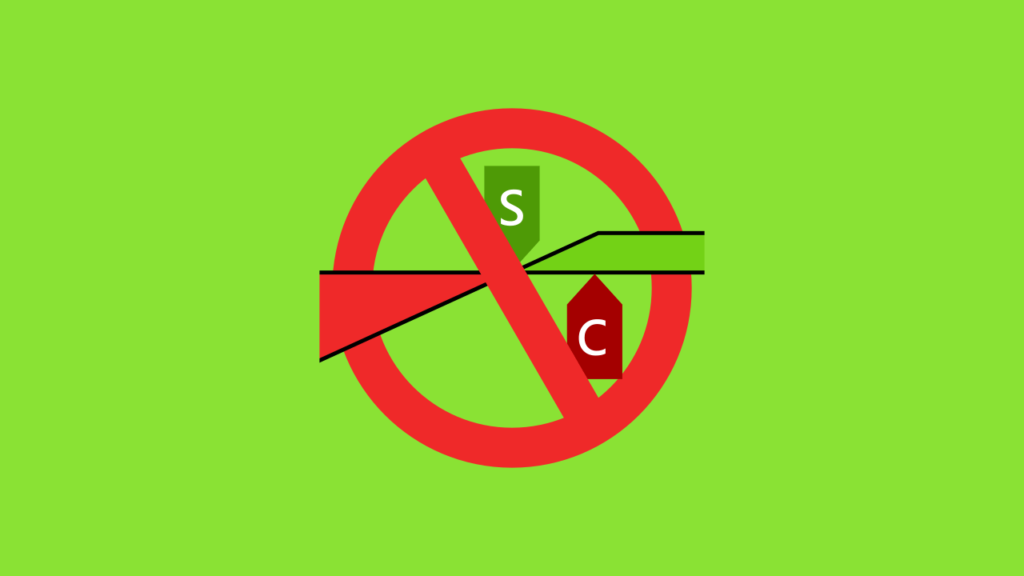
Hey, thank you very much for writing an article about the disadvantages of covered calls, I've just realized that you get small gains. would love to know what are the best strategies that you always suggest?
For bullish opportunities we would sell ATM Put spreads, as they have higher credits and use lower buying power.
For bearish trades, we sell ATM Call spreads for the same reason.
For neutral trades, we usually sell 0.20 delta Strangles because they are easier to roll forward in the event of a loss.
This means a lot.
Covered calls are still a much safer bet, than just selling naked call options. Naked call options are very dangerous when they expire in the money.
Yes, Covered Call is a great alternative to the buy-and-hold strategy.
That's a good point, but it also depends on whether each person's investment habits are conservative or aggressive. Vertical spreads are not only profitable, but they also require a margin to be paid to the brokerage firm, as well as a huge risk of the stock price breaking down. Personally, I feel that covered calls are the fastest and safest way for people who are new to options to get started, but if you are confident in your risk management, you can choose a more aggressive option strategy.
rest assured!
Familiarity with multiple trading strategies that can be used in different situations
You're right.
Covered call is not high risk, but it doesn't work as well as I thought it would!
agree with
Now I think about it, cover call options do have the disadvantages you mentioned
I'll be more careful about trading covered calls from now on
thanks
Thank you for a different perspective on selling covered calls
Covered calls don't seem that great now
Yes, there seems to be more drawbacks than gains for covered calls
I often use the sell covered call strategy to increase the income from my holdings, thank you for sharing different perspectives on this strategy, let me think about how to optimize my US stock trading!
If you have any special ideas on how to optimize your investment strategy, we hope you can share them with us and learn from them.
I was actually looking for the best covered call stocks
After reading this article, I guess I'm done with covered calls now
Thanks!
Yes, although Covered Calls are easy to execute, they have big flaws that turn us off them.
The covered call still has these shortcomings, thank you for sharing.
Yes, Covered Call is not a high risk in theory, but there is a chance that the cost is too high.
What kind of delta do you usually look at for selling covered calls?
When we trade OTM Calls or Puts, we usually start with 0.20 delta to get a good balance of premium and probability of profit.
Then we analyse the price charts again to look for support levels that we can fine-tune our strike prices.
I used to think ETFs and FAANG stocks are the best covered call stocks, because I want to hold on to them for the long term.
Thank you for sharing your perspective, I'll rethink my covered call selling strategies.
Your welcome.
We do think short Covered Calls have huge opportunity costs.
If you want to hold on to stocks and ETFs for the long term, it's probably better to spread out your capital across multiple stocks rather than buying 100 stocks at a time.
It helps you diversify your portfolio and manage your risks.
FAANG stocks are growth stocks and they move quite a bit. If you want to hold them for the long term, don't sell covered calls, it will be painful when your stocks are called away and the stocks keep moving higher. If you want to hold them for the long term, don't sell covered calls, it will be painful when your stocks are called away and the stocks keep moving higher. My buying power is available only once at any given time and I will certainly not use it for selling covered calls due to the low return of 1-2% per month. I would rather sell put spreads with 80-100% ROC per month on FAANG stocks as long as the underlying stock is fundamentally undervalued instead of selling covered calls. If they do not expire worthless, I would roll them into the future because eventually they will expire worthless in case of FAANG stocks. It is safe to sell put spreads on undervalued FAANG stocks. It is safe to sell put spreads on undervalued FAANG stocks. Now, it is not a good time to sell put spreads on FAANG stocks because they are all overvalued or fairly valued except Amazon and Facebook (check the dividend and growth stock database for the fair values. https://slashtraders.com/en/tools/dividend-stock-screener/).
I have been trading covered calls for so long and did not realize that it has a huge opportunity cost until now!
Thank you for the great explanation.
That's right, trading a Covered Call solely to earn a small premium to offset stocks is a big missed opportunity.